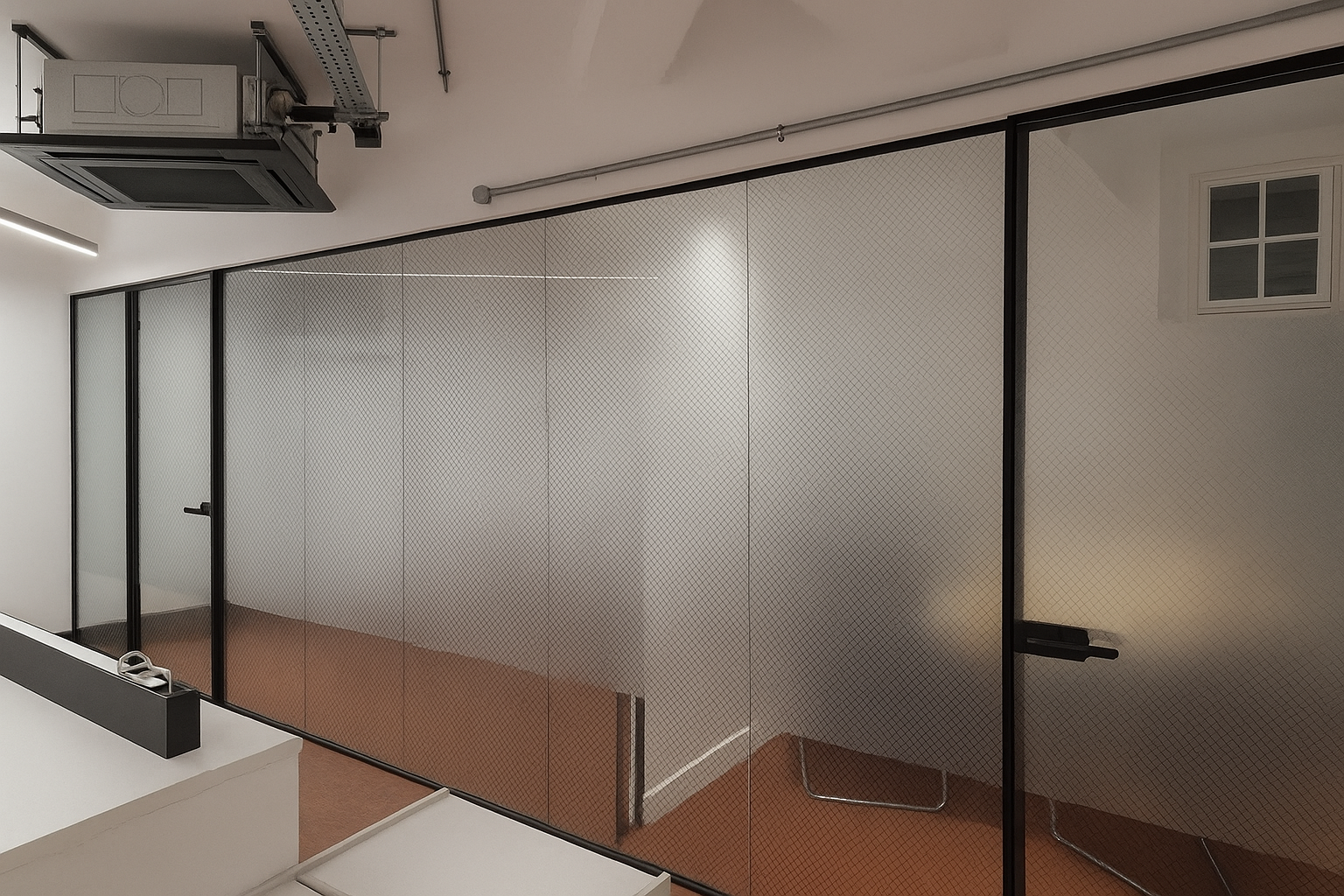
When designing modern commercial spaces, glass plays a central role in balancing openness with privacy. While clear glass creates a transparent and expansive feel, it often lacks discretion. This is why obscure glass becomes a versatile solution. Available in multiple finishes and patterns, obscure glass provides the right blend of light diffusion and privacy, making it ideal for office partitions, meeting rooms, and branded interiors.
In this guide, you’ll learn the different types available, their key features, and how they can be used in commercial environments to enhance both functionality and design.
What is Obscure Glass?
Obscure glass, also known as frosted glass, is a specialized type of glass created to reduce visibility while still allowing natural light to filter through. Unlike standard clear glass, which offers an unobstructed view, obscure glass diffuses light to create varying levels of opacity, ranging from softly blurred to nearly opaque, depending on the finish. The effect is achieved through techniques like acid etching, which gives a smooth, satin-like finish; sandblasting, which produces a slightly textured frosted surface; and patterned rolling, which imprints decorative designs onto the glass.
Learn More: What is Obscure Glass
Why Choose Obscure Glass for Commercial Spaces?
1. Balances natural light with privacy by letting daylight fill the space while keeping sensitive areas discreet.
2. Enhances modern office design with a polished, professional look that complements contemporary interiors.
3. Versatile applications in partitions, doors, meeting rooms, suitable for different spaces, from open-plan offices to private consultation rooms.
4. Low maintenance compared to blinds or curtains.
Popular Types of Obscure Glass
Obscure glass comes in a wide variety of finishes, each offering its own balance of texture, pattern, and privacy. Some of the most widely used types include:
1. Frosted Glass: Created through acid etching or sandblasting, it delivers a smooth, translucent finish that diffuses light while obscuring visibility.
2. Opaque Glass: Blocks visibility almost entirely, ideal for spaces requiring maximum discretion.
3. Patterned Glass: Manufactured with decorative imprints such as ripples, lines, or geometric motifs, adding both privacy and visual interest.
4. Tinted Glass: Infused with subtle color tones that reduce glare and provide moderate privacy with a modern look.
5. Stained Glass: Colored or painted glass arranged into designs, often used for decorative and artistic purposes.
6. Cast Glass: Formed by pouring molten glass into molds, resulting in bold textures and a sculptural appearance.
7. Etched Glass: Created with acid or laser techniques, producing intricate designs, logos, or patterns for custom detailing.
8. Textured Glass: Features raised or embossed textures that scatter light and blur views, commonly used in partitions and doors.
9. Seeded Glass: Contains tiny bubbles within the glass, giving it a handcrafted, vintage character while maintaining partial visibility.
Comparing Different Types of Obscure Glass
The right type of obscure glass depends on the desired balance of privacy, durability, and aesthetics. Below is a comparison of the most common options:
| Type of Obscure Glass | Finish | Privacy Level | Durability | Best Use Cases |
| Frosted Glass | Smooth, satin-like surface | Medium to high | Strong (can be toughened/laminated) | Office partitions, shower screens, meeting rooms |
| Opaque Glass | Solid, non-transparent | Very high | Strong | Healthcare rooms, private offices, restrooms |
| Patterned Glass | Decorative imprints (ripples, lines, motifs) | Medium | Moderate, depends on thickness | Retail displays, feature walls, doors |
| Tinted Glass | Colored finish (grey, bronze, green, etc.) | Low to medium | Moderate, reduces glare | Modern offices, façades, lobbies |
| Stained Glass | Colored/patterned decorative | Low to medium | Moderate, depends on installation | Hospitality, feature panels, decorative interiors |
| Cast Glass | Bold, sculptural textures | Medium | Highly durable | High-end partitions, statement walls |
| Etched Glass | Custom surface designs | Medium to high | Moderate, depending on finish | Branding, signage, bespoke interiors |
| Textured Glass | Embossed/raised surface | Medium | Strong (often laminated) | Partitions, doors, decorative glazing |
| Seeded Glass | Bubbled/vintage effect | Low to medium | Moderate | Boutique retail, restaurants, decorative panels |
Key Features to Look for in Obscure Glass
1. Privacy vs. light balance: Obscure glass provides the right mix of visibility control and daylight, keeping spaces bright while ensuring discretion in meeting rooms, receptions, or retail displays.
2. Durability and safety standards: Available in toughened or laminated options, it meets commercial safety regulations and withstands the demands of busy offices, hotels, and healthcare facilities.
3. Design flexibility and patterns: From frosted and etched to tinted or patterned finishes, obscure glass adapts to different design styles and can incorporate branding for added impact.
4. Easy maintenance: Unlike blinds or curtains, obscure glass is simple to clean, with many finishes resistant to fingerprints and smudges.
5. Suitability for high-traffic areas: Strong and resilient, it maintains its look and performance in high-use spaces like offices, gyms, and retail environments.
Applications in Commercial Environments
1. Office partitions and meeting rooms: Obscure glass creates privacy for meetings and focused work while keeping offices bright and open. It’s a modern alternative to blinds or solid walls in open-plan layouts.
2. Retail storefronts and displays: Commonly used in shopfront glazing, dressing rooms, and display panels, obscure glass helps showcase products while hiding storage or back-office areas. It can also be customised with branding or patterns to strengthen the store’s identity.
3. Hospitality: Frequently installed in restaurant lobbies, longues, hotels, dining zones, spa areas, and private booths, it adds elegance while creating separation. Guests enjoy intimate spaces without losing natural light, making interiors more inviting.
4. Leisure & healthcare facilities: Ensures discretion in gyms, spas, and clinics while keeping spaces bright, hygienic, and compliant with safety standards.
Final Thoughts
Obscure glass is a versatile, stylish, and practical choice for modern interiors, offering design flexibility that suits a variety of commercial spaces. With options ranging from frosted to patterned and textured finishes, it brings character and functionality to offices, retail, hospitality, and leisure environments.
The best results come from choosing a type that aligns with the project’s design vision, privacy, and functional needs. Beyond aesthetics, obscure glass contributes to creating professional, welcoming, and durable spaces that support how businesses operate today.
FAQs
Yes. Obscure glass can be laminated with acoustic interlayers to reduce noise transmission, making it suitable for offices, meeting rooms, and other sound-sensitive spaces.
Obscure glass can improve energy performance when paired with coatings or double glazing, helping regulate temperature while reducing glare.
It should comply with building regulations such as BS EN 12150 for toughened glass or BS EN 14449 for laminated glass, ensuring durability and safety in high-traffic environments.
While primarily designed to soften glare and control visibility, certain treatments and coatings can also help reduce solar heat gain.
Yes. It can be installed into existing frames or partition systems without requiring a full replacement, making it a flexible upgrade.
Absolutely. With the right treatment and lamination, obscure glass works for façades, skylights, and other external architectural features.
Pricing varies by type; frosted and patterned options are generally more cost-effective, while custom etched, stained, or textured designs sit at the higher end.














